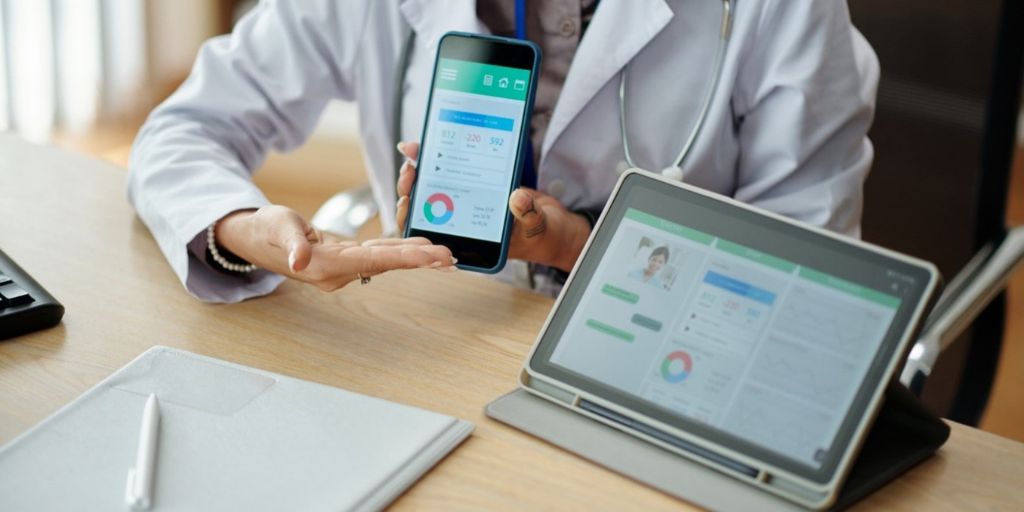
Within any app store, a large variety of apps related to health and medical care can be found, however not all of these apps are regarded as Health apps, some are regarded as Software as a Medical Device (SaMD) applications. There is a big difference between a Health app and a SaMD application. Understanding the difference between these two types of applications is important for healthcare professionals, developers and consumers.
What is a Health App?
Health apps, most commonly found on smartphones, tablets and wearable devices (like smart watches), encompass a wide range of applications designed to support general health and wellness goals. Apps in this category can include fitness and calorie trackers, medication reminders, symptom diaries, and meditation guides, among many others. Their primary focus is providing users with tools and resources to monitor and improve their health behaviours and general lifestyle habits.
While health apps offer valuable support for self-care and health management, they are not regulated as medical devices by regulatory authorities such as the U.S. Food and Drug Administration (FDA), Medicines and Healthcare products Regulatory Agency (MHRA) or equivalent in EU member states. They lack the rigorous testing and validation required for regulated software , raising concerns about their accuracy, reliability, and safety for medical purposes.
It is assumed that developers of health apps will comply with standards such as CEN/ISO 82304-2 (Health and wellness apps – quality and reliability). However, this is not a mandatory standard, so many apps are released without the necessary product safety, quality and reliability assessments.
What is SaMD?
SaMD may share the same technological functions and be available on the same devices as Health apps, but they differ in their intended purpose. SaMD applications are specifically designed for clinical and medical purposes i.e. to diagnose, treat, monitor, or prevent medical conditions. Or simply put: “software intended to be used for one or more medical purposes that perform these purposes without being part of a hardware medical device.” International Medical Device Regulators Forum (IMDRF).
These applications fall under the category of medical devices and are intended for use alongside medical interventions, under the supervision of healthcare professionals or by the patient themselves.
SaMD is software that is independent of other existing medical devices but often works in conjunction with a medical device. Some examples of these include electrocardiogram (ECG) monitors, glucose monitoring systems, and diagnostic imaging software. This is often mistaken for Software in a Medical Device (SiMD), which is the internal software of a medical device that runs the hardware of that device.
Because SaMD applications function as government-regulated medical devices, they are subject to regulatory oversight and approval. If an app is ‘UKCA or CE’ marked, it means the manufacturer of the SaMD has met all of the regulatory requirements concerning safety and performance, i.e. it is safe and fit for the purpose it was declared for.
The process of developing a SaMD application must acknowledge certain standards, including IEC 81001-5-1 (Health software and health IT systems safety, effectiveness and security – Part 5-1: Security – Activities in the product life cycle), which is concerned with cybersecurity and IT systems in the development and lifecycle of health software.
This standard introduces best practices for app manufacturers and as part of the software development, there must be a secure coding standard established to implement software systems that are secure and effective. Protecting unauthorised access, removing backdoors and including simple design are among the specified best practices of this regulation.
The Difference
The difference between a standard Health app and a SaMD application is vast. One is used by health-conscious people in their daily lives for help with their lifestyle and habits, and the other is a regulated software most often used by medical health professionals and patients. Despite being under the same umbrella term of ‘health and medical app’, they vary greatly in their functions, uses and standards.
App creators need to distinguish the type of app they are creating and ensure the intended purpose of the app is clear to keep within the guidelines and meet the required legislation. If the app being created is classed as SaMD then it can be useful to make use of software such as Coauthor to help with setting up QMS documentation and reach compliance quicker and easier.











